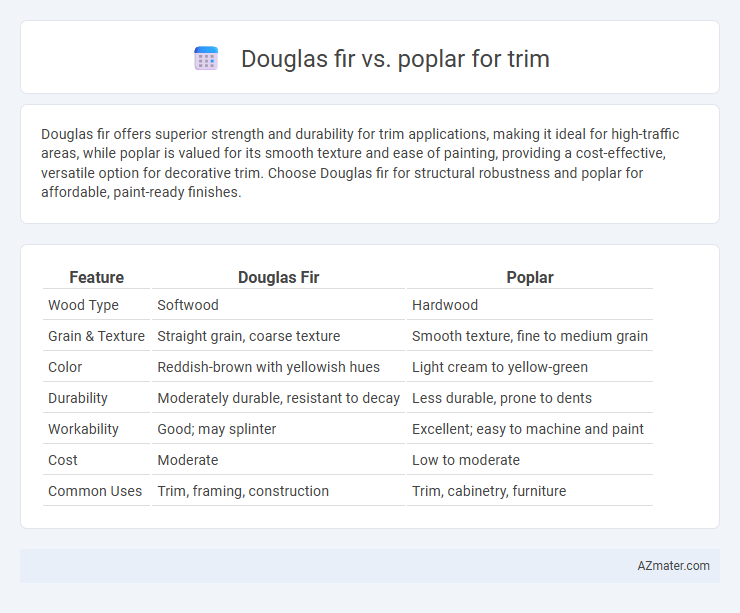Douglas fir offers superior strength and durability for trim applications, making it ideal for high-traffic areas, while poplar is valued for its smooth texture and ease of painting, providing a cost-effective, versatile option for decorative trim. Choose Douglas fir for structural robustness and poplar for affordable, paint-ready finishes.
Table of Comparison
| Feature | Douglas Fir | Poplar |
|---|---|---|
| Wood Type | Softwood | Hardwood |
| Grain & Texture | Straight grain, coarse texture | Smooth texture, fine to medium grain |
| Color | Reddish-brown with yellowish hues | Light cream to yellow-green |
| Durability | Moderately durable, resistant to decay | Less durable, prone to dents |
| Workability | Good; may splinter | Excellent; easy to machine and paint |
| Cost | Moderate | Low to moderate |
| Common Uses | Trim, framing, construction | Trim, cabinetry, furniture |
Introduction to Douglas Fir and Poplar for Trim
Douglas fir offers exceptional durability, tight grain, and resistance to wear, making it ideal for trim that requires long-lasting strength and a refined, natural appearance. Poplar, known for its smooth texture and ease of painting, provides a cost-effective option for trim where a uniform surface and versatility in finishing are essential. Both woods serve distinct purposes in trim applications, with Douglas fir favored for structural integrity and Poplar chosen for its adaptability and affordability in decorative elements.
Wood Characteristics: Douglas Fir vs Poplar
Douglas Fir offers superior strength and durability with a coarse grain and reddish-brown color, making it ideal for trim that requires resilience and a rustic appearance. Poplar features a fine, even grain with a creamy white to light greenish hue, providing a smooth surface that readily accepts paints and stains, perfect for versatile and cost-effective trim options. Both woods differ significantly in hardness and appearance, influencing their suitability based on whether durability or ease of finishing is prioritized.
Durability and Strength Comparison
Douglas fir offers superior strength and durability compared to poplar, making it ideal for trim in high-traffic or impact-prone areas. Its dense grain structure provides resistance to dents, wear, and moisture, enhancing longevity. Poplar, while easier to work with and more affordable, lacks the robustness of Douglas fir and is more prone to dents and surface damage.
Aesthetic Differences and Grain Patterns
Douglas fir features a rich reddish-brown hue with prominent, straight grain patterns that add warmth and a natural rustic appeal to trim applications. Poplar, on the other hand, offers a lighter, creamy white to pale yellow coloration with a more subtle and uniform grain, making it ideal for painted trim where smoothness is preferred over pronounced texture. The distinct grain visibility in Douglas fir enhances decorative trim, whereas Poplar's restrained grain supports a contemporary, clean finish.
Workability and Ease of Installation
Douglas fir offers excellent workability due to its straight grain and moderate hardness, allowing for smooth cutting, nailing, and sanding during trim installation. Poplar is softer and lighter, making it easier to machine and shape, but it may dent or scratch more easily compared to Douglas fir. Both woods are relatively easy to install, though Douglas fir's durability provides more resistance to wear and tear in high-traffic areas.
Paintability and Finishing Options
Douglas fir offers a tight, straight grain that accepts paint well, providing a smooth, even finish ideal for trim applications. Poplar's fine texture and low resin content make it highly receptive to both paint and stain, allowing for versatile finishing options with minimal preparation. While Douglas fir is durable and holds paint firmly, poplar's uniform surface reduces the risk of blotching, making it a preferred choice for detailed trimwork requiring a flawless painted or stained appearance.
Cost Comparison: Douglas Fir vs Poplar
Douglas fir typically costs more than poplar for trim due to its superior strength and durability. Poplar is often chosen for budget-friendly projects as it is more affordable and easier to work with, making it a popular option for painted trim. Cost differences vary by region and availability, but poplar generally offers a lower price point compared to Douglas fir.
Environmental Impact and Sustainability
Douglas fir trim features rapid growth and high carbon sequestration rates, making it a more sustainable choice with a lower environmental footprint compared to poplar. Poplar, while fast-growing, often requires more intensive chemical treatments due to its softer wood, increasing its environmental impact. Choosing Douglas fir helps reduce deforestation pressure due to its widespread availability and efficient growth cycles.
Common Applications in Trimwork
Douglas fir is favored in trimwork for its strength and fine grain, making it ideal for baseboards, crown molding, and door casings that require durability and a smooth finish. Poplar is commonly used for painted trim applications due to its consistent texture and ease of machining, often chosen for window casings and decorative moldings where a clean, paintable surface is desired. Both woods offer versatility, but Douglas fir suits projects emphasizing natural wood grain, while poplar excels in cost-effective, paint-ready trim installations.
Choosing the Best Wood for Your Trim Project
Douglas fir offers exceptional durability and a fine grain, making it ideal for trim projects requiring strength and a smooth finish. Poplar is favored for its affordability and ease of painting, providing a uniform surface that accepts paint well but lacks the hardness of Douglas fir. Selecting Douglas fir ensures long-lasting trim with a natural wood aesthetic, while poplar suits painted trim applications prioritizing budget and versatility.

Infographic: Douglas fir vs Poplar for Trim
 azmater.com
azmater.com